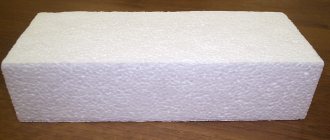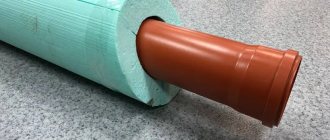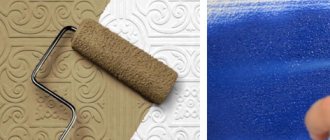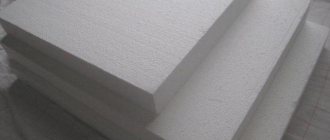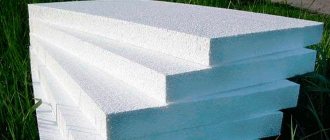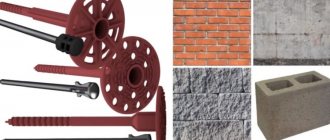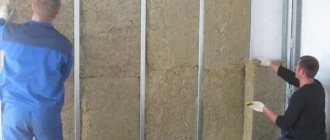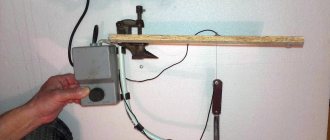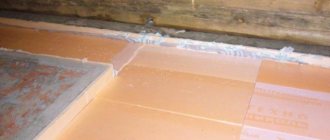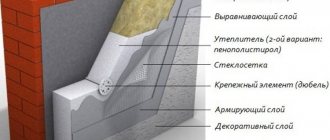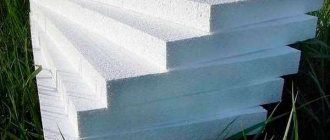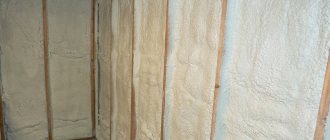Extruded polystyrene foam XPS (EPS) is a relatively “young” thermal insulation material that has gained wide recognition due to its unique combination of characteristics. The material does not shrink, does not absorb moisture and does not swell, and it is also chemically resistant and does not rot. Due to the high strength of polystyrene foam, it is possible to obtain a rigid base for the thermal insulation system, which significantly increases its service life. The material has many more advantages, which is what made it so widespread.
What is XPS Extruded Polystyrene Foam
Another name for extruded polystyrene foam XPS (eXtruded PoliStyrene) is extrusion. A similar term is applied to materials that are produced by extrusion - by forcing a viscous melt through a molding hole. First, polystyrene granules are mixed with foaming agents (freons or carbon dioxide-based compounds), then mixed under high pressure, and only then squeezed out of the extruder.
Extruded polystyrene foam has a fine-cell structure
At its core, expanded polystyrene is a plastic with evenly distributed closed cells measuring 0.1-0.2 mm. Externally, the material looks like a smooth plate - transparent or colored. The fine-mesh structure can be easily seen directly on the cut. The edges of the slabs can be straight or in the form of an L-shaped edge, which provides more reliable adhesion of the products during installation. You can explore different types of extruded polystyrene foam by going to the product catalog.
Characteristics of extruded polystyrene foam
The interest of many consumers in extruded polystyrene foam was caused by its high performance. You can easily verify this by considering the main characteristics of the material:
- Thermal conductivity coefficient – λ = 0.029 W/m·K. The lowest rate among all existing insulation materials, even lower than that of the softest mineral wool board.
- Density (specific gravity) – 25-45 kg/m3. Provides lightness of the slabs, ease of installation, as well as low cost of handling and ease of storage.
- Water absorption – 0.2% at full immersion. Since the indicator is very low, sometimes it is even neglected in calculations. Such insignificant moisture absorption is ensured by the closed cell structure. Water cannot penetrate them under any circumstances, only if the integrity is broken when the slab is cut. But even in this case, the absorption of water is negligible.
- Compressive strength at 10% deformation – 15-100 t/m2 (150-1000 kPa). According to this parameter, XPS meets the most stringent requirements for insulation materials.
An example of insulating a brick wall using extruded polystyrene foam
Advantages of extruded polystyrene foam
The advantages of XPS expanded polystyrene also stem from its unique characteristics, the list of which is supplemented by:
- High frost resistance – withstands temperatures down to -70 °C without loss of properties. Allows the use of the material at extremely low temperatures, even in the Far North.
- High degree of fire resistance. This is achieved through additives – fire retardants, which are added to the composition of polystyrene foam. This makes the material self-extinguishing, meaning it will only burn when in direct contact with a fire source.
- Chemical resistance. XPS is not affected by acids, oils, alkalis, alcohol, saline solutions, dyes, ammonia and many other substances.
- Safety for humans. It is allowed to use the material in children's and medical institutions.
- Biostability. Eliminates the occurrence of mold and mildew on the material, since it is not a breeding ground for them.
- Durability. XPS has a service life of up to 45 years.
Disadvantages of XPS Expanded Polystyrene
- Insufficient vapor permeability – 0.007-0.008 mg/m·h·Pa.
- Flammability. Even despite its self-extinguishing properties, the material burns when in contact with fire.
- Low sound insulation. Compared to mineral wool and polystyrene foam, polystyrene foam protects less well from external noise.
- Blowability of seams. It occurs due to the rigidity of the material, but this problem can be solved by laying slabs with bandaging. For example, if the calculation requires slabs with a thickness of 100 mm, then you need to buy 50 mm slabs, but 2 times larger.
General characteristics and use
Insulation is used for cladding:
- balconies and loggias;
- basements;
- facades;
- foundations;
- expressways;
- blind area;
- runways.
The material is used for cladding horizontal and vertical surfaces: walls, floors, ceilings.
Experts working in the repair industry note that XPS boards are one of the most common insulation materials. The wide scope of use and technical features played an important role in the popularity of the products.
Due to high demand on the market, you can often find products from unscrupulous manufacturers who violate the manufacturing process. As a result, customers risk buying a low-quality product. Any inaccuracies in production cause a significant reduction in the service life of the insulation and its characteristics.
You will learn further about how to use extruded polystyrene foam in a residential environment.
The standard XPS color is white. This is the most common option. However, the insulating finish may have a silver color. The color changes due to the inclusion of a special component - graphite. This product is designated with special markings. Silver plates have increased thermal conductivity. The characteristic is achieved by adding nanographite to the raw material.
It is recommended to choose the second option if you want to purchase the most reliable, practical and effective insulation.
Where is XPS expanded polystyrene used?
Due to low vapor permeability, XPS is not recommended for use in the interior of residential and public buildings. Otherwise, the microclimate inside the facility will not be very favorable.
The use of XPS for interior work is permitted only in buildings that are equipped with a reliable forced-air supply and exhaust ventilation and air conditioning system. This is especially true for multi-storey buildings, where it is impossible to insulate the outside of the building and have to do it from the inside.
In other cases, XPS polystyrene foam is very widespread, especially in Russia, where there are a lot of wet and swampy soils. The unique properties of the material allow it to be used for insulation:
- foundations,
- roofs,
- floors,
- facades.
Work on building insulation with extruded polystyrene foam
Extruded polystyrene foam can be used to insulate various engineering structures, private and industrial construction sites, namely the floors of the first floors, basement and semi-basement basements. In the case of facades, such insulation can be used both in the “wet” method (plaster) and when installing a ventilated frame structure under siding. The scope of application of XPS expanded polystyrene also includes insulation:
- tunnels;
- highways on permafrost and heaving soils;
- airports;
- parking;
- garages;
- runways.
The use of extruded polystyrene foam for insulation under siding
How to choose the right polystyrene foam
We have talked enough about the pros and cons, the strong and weak properties of EPP. The time has come to decide what we should devote our time to when purchasing material and what to pay attention to. A good seller praises his product, feeling the desire to sell it quickly. Our task is to buy extruded polystyrene foam of the best quality.
The best solution would be to purchase goods from well-known, reputable suppliers offering equally well-known manufacturer brands. Foreign brands such as Basf or Novachemicals will meet all your expectations. Of the Russian companies, in fairness, it is worth noting that the quality of their products is no worse than that of imported ones, we recommend paying attention to the Penoplex brands URSA, Knauf and Technonikol.
If the above brands are not available on the market, carefully study the technical instructions. The EPP designation begins with two numbers. Refuse to purchase if the marking value is less than index 28; such a polymer is not suitable for construction and insulation work. It is not beneficial for the seller to mention this, and most likely he will modestly keep silent about it. For facade work on thermal insulation, the PSB-S-40 brand is ideal; in addition, it is a self-extinguishing material.
A quick quality check can be done by breaking a small piece of polystyrene foam. A smooth fault indicates that you are facing an EPP. Otherwise, if the break line is uneven and there are many small balls, then most likely you have ordinary foam plastic in your hands, which is only suitable for packaging household utensils.
You need to understand that manufacturing EPP is a complex process, and different manufacturers do it using different technologies. Some of them are completely safe for health, others cause irreparable harm to humans.
When choosing extruded polystyrene foam, look at large companies that have long established themselves as reliable manufacturers. In this case, we can speak with confidence about an undoubtedly high-quality product. Unknown brands with big names may be initially more profitable, but the risks associated with subsequent alterations will cost you much more!
Remember that the poor quality of polystyrene foam will not only not serve as a good heat insulator, but will also have a negative impact on the health of your loved ones.
Differences between XPS and EPS polystyrene foam
There are 2 types of expanded polystyrene: extruded (XPS, eXtruded PoliStyrene) and foamed (EPS, Expanded PolyStyrene). In terms of chemical properties and thermal conductivity, the materials are very similar to each other, but some of their properties are fundamentally different:
- Compressive strength.
It is higher for XPS, but this is not important in all cases. Engineers determine the required strength. For most projects, EPS is sufficient, which allows you to save money on the budget, but for work with the foundation, XPS is still recommended, since it requires high-performance thermal insulation.
- Moisture retention.
Another argument in favor of using XPS for insulating the foundation and the soil around it (to prevent freezing), since this material does not absorb water. It is recommended to exclude the use of EPS in such cases. It has low water absorption (2%), but in the case of insulation of the foundation this can be critical. Soil in direct contact can cause the EPS to deteriorate over time.
- Insulating ability.
EPS has exactly the same vapor permeability as wood, and wooden houses are considered the most favorable in terms of microclimate. The XPS cannot boast of such properties. When insulating the walls in the house with it, the humidity slightly increases and the air exchange decreases. In this regard, when carrying out interior work, XPS is most popular in cases where it is necessary to reclaim square meters, for example, on a loggia. Here, the use of XPS will eliminate dampness of the walls and provide the required degree of thermal insulation without increasing its layer.
Prevention type thermal insulation
Organic-based thermal insulators
Organic insulation materials are quite widely represented on the modern construction market. For their production, raw materials of natural origin (agricultural and woodworking waste) are used. Organic heat insulators also include some types of plastic and cement.
The resulting material is highly resistant to fire, does not get wet, and does not react to biologically active substances. It is used where the surface does not heat above 150 degrees. An organic thermal insulator is often placed as the inner layer of a multi-layer structure. These are, for example, triple panels or plastered facades. Next, we will consider what types of organic insulation there are.
1. Arbolite insulation.
This fairly new building material is made from small sawdust, shavings, chopped straw or reeds. Cement and chemical additives are added to the base. These are calcium chloride, alumina sulfate and soluble glass. At the last stage of production, the products are treated with a mineralizer.
The characteristics of wood concrete are as follows:
- Density - from 500 to 700 kilograms per cubic meter.
- Thermal conductivity coefficient is from 0.08 to 0.12 watts per meter per Kelvin.
- Compressive strength is from 0.5 to 3.5 megapascals.
- Bending strength is from 0.4 to 1 megapascal.
2. Foam polyvinyl chloride insulation.
PPVC consists of polyvinyl chloride resins, which, after porousization, acquire a special foam structure. Since this material can be either hard or soft, it is a universal heat insulator. There are various types of insulation for walls, roofs, facades, floors and entrance doors made of PVC. The density (average value) of this material is 0.1 kilograms per cubic meter.
3. Chipboard insulation.
Particle boards are basically made of small chips. It makes up nine-tenths of the total volume of material. The rest is synthetic resins, antiseptic substance, antiprene, water repellent.
The characteristics of chipboard are as follows:
- Density - from 500 to 1000 kilograms per cubic meter.
- Tensile strength is from 0.2 to 0.5 megapascals.
- Bending strength is from 10 to 25 megapascals.
- Humidity – from 5 to 12 percent.
- Water absorption by the material is from 5 to 30 percent.
4. DVIP insulation.
Wood fiber insulation board has a composition similar to chipboard. The basis is either wood waste or trimmings of straw and corn stalks. It could even be old paper. Synthetic resins are used to bind the base. Additives include antiseptics, fire retardants and water-repellent substances.
The characteristics of DVIP are as follows:
- Density – no more than 250 kilograms per cubic meter.
- Bending strength is no more than 12 megapascals.
- Thermal conductivity coefficient is up to 0.07 watts per meter per Kelvin.
Wood fiber insulation.
5. Polyurethane foam insulation.
Polyurethane foam is based on polyester, to which water, emulsifiers and diisocyanate are added. Under the influence of a catalyst, all these components enter into a chemical reaction, forming a new substance. It has a good level of noise absorption, is chemically passive, and is not afraid of moisture. In addition, polyurethane foam is an excellent heat insulator. Since it is applied by spraying, it is possible to process walls and ceilings of complex configurations. In this case, cold bridges do not appear.
Characteristics of polyurethane foam:
- Density - from 40 to 80 kilograms per cubic meter. When the density reaches 50 kilograms per cubic meter, polyurethane foam becomes moisture resistant.
- Thermal conductivity coefficient is from 0.019 to 0.028 watts per meter per Kelvin. This value is the best of all modern thermal insulation materials.
Application of polyurethane foam insulation to the surface of the walls.
6. Mipora (penoizol).
If you beat urea-formaldehyde resin, or rather its aqueous emulsion, you get mipora. To prevent the material from being brittle, glycerin is added to the raw material. To form foam, sulfonic acids derived from petroleum are added. And the catalyst that promotes hardening of the mass is an organic acid. Mipore is sold both in crumb form and in blocks. If it is supplied in liquid form, then it is poured into special cavities during construction. There, at room temperature, it becomes solid.
Characteristics of the mipora:
- Density – no more than 20 kilograms per cubic meter. Compared to cork, this figure is approximately 10 times less.
- The thermal conductivity coefficient is about 0.03 watts per meter per Kelvin.
- Ignition temperature is more than 500 degrees. If the temperature is below this value, then this material does not burn, but only undergoes charring.
- The disadvantages of mipora are vulnerability to the effects of aggressive chemicals, as well as strong absorption of water.
- See the material >>Technical characteristics of penoizol, its properties and disadvantages as insulation
7. Expanded polystyrene.
Expanded polystyrene, also known as EPS, also known as polystyrene foam, consists of 98 percent air. The remaining 2 percent is polystyrene, which is obtained from petroleum. Expanded polystyrene also contains a small amount of modifiers. In particular, these may be fire retardants.
Properties of PPP:
- Thermal conductivity coefficient is from 0.037 to 0.042 watts per meter per Kelvin.
- Waterproofing qualities are high.
- Corrosion resistance – high.
- Resistance to bioagents and microflora is high.
- Flammability – low. The material can fade on its own. If polystyrene foam does catch fire, it releases 7 times less thermal energy than wood.
Expanded polystyrene boards.
Plates of simple foam plastic can also be classified as this type of insulation.
8. Insulation made of foamed polyethylene.
If we add a foaming agent (one of the types of hydrocarbons) to polyethylene during the manufacturing process, we will get a material with numerous small pores inside. It has good vapor barrier properties and also provides excellent protection from external noise.
Properties of foamed polyethylene:
- Density - from 25 to 50 kilograms per cubic meter.
- Thermal conductivity coefficient is from 0.044 to 0.051 watts per meter per Kelvin.
- The temperature range of application is from minus 40 to plus 100 degrees.
- Moisture absorption is low.
- Chemical and biological passivity is high.
Foamed polyethylene in rolls is often produced in a special shape for pipe insulation.
9. Fibrolite.
Taking narrow and thin wood shavings, which are also called wood wool, as a basis, adding cement or a magnesium component for binding, we get fiberboard. It is available in the form of slabs. This material is not afraid of chemical and biological aggressive influences. It protects well from noise and can also be used in rooms where it is very humid. These are, for example, swimming pools.
Characteristics of fiberboard:
- Density - from 300 to 500 kilograms per cubic meter.
- Thermal conductivity coefficient is from 0.08 to 0.1 watts per meter per Kelvin.
- Fire resistance – high.
10. Honeycomb insulation.
As a rule, this material consists of hexagonal cells, reminiscent of a honeycomb - hence the name. However, there are types of honeycomb plastic, where the shape of the cells is different from the hexagon. The filler is a special fabric or paper based on carbon, cellulose, organic or glass fibers coated with a film. These fibers are bound using thermoactive resins - phenolic or epoxy. The outer sides of honeycomb panels are thin sheets of laminated plastic.
Popular manufacturers of extruded polystyrene foam
The number of companies producing XPS foam is growing steadily, but a few manufacturers still remain in the lead. Among them there are both domestic and foreign companies. The most popular of them are presented in the table.
| Name | Logo | A country | Product Features |
| Eryap | Türkiye | The company produces Bonuspan expanded polystyrene panels. The capillarity of the material is practically zero. | |
| IZOCAM | Türkiye | In the production of XPS boards, the company uses developments from American companies. The latest technologies allow the manufacturer to use lightweight but durable material. | |
| "Elite-Plast" | Ukraine | The large-area production complex allows the production of extruded polystyrene foam on an unlimited scale. The products comply with the Kyoto Protocol, therefore eliminating environmental pollution. The products are produced under the Penoboard brand, predominantly blue in color. | |
| "TechnoNIKOL" | Russia | The company produces its own types of XPS expanded polystyrene - "TechnoNIKOL" and "TECHNOPLEX" for insulating loggias, floors, balconies, foundations and walls in basements. | |
| "PENOPLEX" | Russia | Another large Russian manufacturer of EPS. In line extruded polystyrene foam XPS "PENOPLEX" bright orange slabs are presented:
| |
| Fibran | Greece | Fibran Eco XPS boards are environmentally friendly because they do not use freon in their production, which makes the material absolutely harmless. The production of the material is organized in Bulgaria. The slabs have a bright turquoise color. | |
| Ursa | Germany | One of the well-known European companies that produce insulating materials. The XPS URSA expanded polystyrene line includes predominantly white slabs with a thickness of 30-100 mm and a density of 30-50 kg/m3 in several varieties:
|
The widest range of extruded polystyrene foam from
The assortment of popular domestic products includes variations of insulation for a variety of areas of construction. The most common versions of the material:
- Extruded polystyrene foam "TechnoNIKOL" XPS Carbon Eco . Contains carbon particles that increase strength, reduce thermal conductivity and give the material a lightened tone with a silvery tint.
- "TechnoNIKOL" Carbon Prof. Professional building material. It has high strength and the lowest thermal conductivity coefficient. Suitable for almost all types of foundations. The line also includes slabs for creating a slope on a flat roof (Prof Slope).
- "TechnoNIKOL" Carbon Eco Drain. Designed for lining wall drainage, for which it is equipped with drainage channels or ribbing. By using this material on flat roofs, you can get rid of stagnant water.
- "TechnoNIKOL" Carbon Eso Fas. This type of slab is distinguished by a characteristic milling, which ensures particularly high adhesion to the base. The use of the material is relevant for plinths and plaster facades.
- "TechnoNIKOL" Carbon Sand Mon. Special slabs for thermal insulation of monolithic buildings. Used as an insulation layer for sandwich panels. There are also analogues of these boards: Sand PVC for PVC sandwich panels and Sand VAN, designed for thermal insulation of isothermal cars.
Extruded polystyrene foam XPS "TechnoNIKOL"
XPS line of extruded polystyrene foam also includes:
- “TECHNOPLEX 30 250” (λ = 0.027 W/m K).
- “TECHNOPLEX 35 250” (λ = 0.028 W/m K).
- “TECHNOPLEX 45 500” (λ = 0.030 W/m K).
"TECHNOPLEX" was developed mainly for private and country houses. The material is distinguished by the use of nanographite in the production, which increases strength. Due to the addition of graphite particles, the plates acquire a light silver color, thanks to which they can be easily distinguished from ordinary ones.
Extruded polystyrene foam technical characteristics:
I would like to draw special attention to the fact that manufacturers often lie when advertising a product about its fire-fighting properties. Of course, the material does not ignite from a carelessly discarded cigarette or a smoldering cigarette butt, but from a sparkling electric welder or match, absolutely nothing will flare up like that. Many people have seen the EPP burn more than once. Everyone notes that when the material burns, black clouds of acrid smoke with a pungent odor are formed.
Taking into account the experience of residents of the European Union, who have been successfully using extruded polystyrene foam in residential buildings for many years, it can be noted that our domestic homeowner will always choose a thicker sheet for insulation. Europeans, as a rule, consider 3-4 mm sufficient. Of course, their winter is not so severe, you will say, and you will be partly right.
But on the other hand, in the event of a fire, a thin layer of thermal insulation releases significantly less toxic substances into the room. Household members will be able to leave the building without causing significant harm to their health. Why don't people completely abandon hazardous materials? The point here is not even the arrogance of citizens of the European Union, but the fact that the positive properties of EPP are so numerous that fastidious foreigners forget to pay attention to minor “shortcomings”.
You should not use EPP as thermal insulation for structures where elevated temperatures are expected, such as baths or saunas. As we mentioned, sun rays, or more precisely ultraviolet radiation, have a destructive effect on EPP. Cover the thermal insulation with a layer of paint or reliable cement mortar. Avoid exposure of the material to sunlight even for a short period of time!
As for the large thickness, it should be noted that extruded polystyrene foam does not “like” sudden changes in temperature very much. Under the influence of this kind of extreme changes, the EPP has been observed to develop cracks.
There is a danger that over time frosty air will penetrate through the cracks. On the other hand, the statement that the thicker the polystyrene foam we use, the warmer our room is, is absolutely indisputable. Attention video:
How to calculate the amount of extruded polystyrene foam
One of the simplest methods for calculating the amount of thermal insulation material is based on the surface area that needs to be insulated. To do this you need:
- Take plans, facades or wall layouts - it all depends on what you are going to insulate.
- Having determined the length and width of the insulated surface, calculate its area - S, m2. For example, let's take a value of 10 m2.
- Take the area of one expanded polystyrene slab - P, m2. For example, extruded polystyrene foam “TechnoNIKOL CARBON ECO 1180x580x30 mm” has an area of the largest side of 1.18 · 0.58 = 0.6844 m2.
- Next, divide the area of the entire insulated surface by the area of one slab and multiply by 1.05-1.1 (for reserve for scraps) - S / P · 1.05 = 10 / 0.6844 · 1.05 = 15.34 pcs. When rounded to the nearest whole number you get 16 pieces. – this is the number of slabs required to insulate a surface of 10 m2.
Manufacturers
We recommend purchasing products from the following manufacturers, as their products are proven for quality, reasonable prices and a huge range of types.
Knauf
Expanded polystyrene Knauf
Thermal insulation is available in three modifications: Compack - for universal use in construction, Wall - for walls only, Flor - for insulating floors and plinths, Roof Light - for laying an insulating layer of the roof and attic, 5 in 1 - for foundations and structures that are subject to weight loads.
Penoplex
EPPS PENOPLEX
Domestic insulator, which is marked for specific areas of application: walls, roofing, foundation. The Penoplex Comfort modification is used as slabs for universal use, and Penoplex 45 is used for slabs with an increased fracture limit.
Technoplex
Technoplex from TECHNONICOL
The domestically produced TechnoNIKOL brand is characterized by the properties of strength and lightness. Scope of application: construction of structures, buildings and roads. The most popular are: Carbon Prof, Carbon Solid, Carbon Fas, Carbon Sand. They have high strength, thermal conductivity and plasticity, which is realized in the manufacture of sandwich panels, road surfaces, walls, foundations and roofs.
